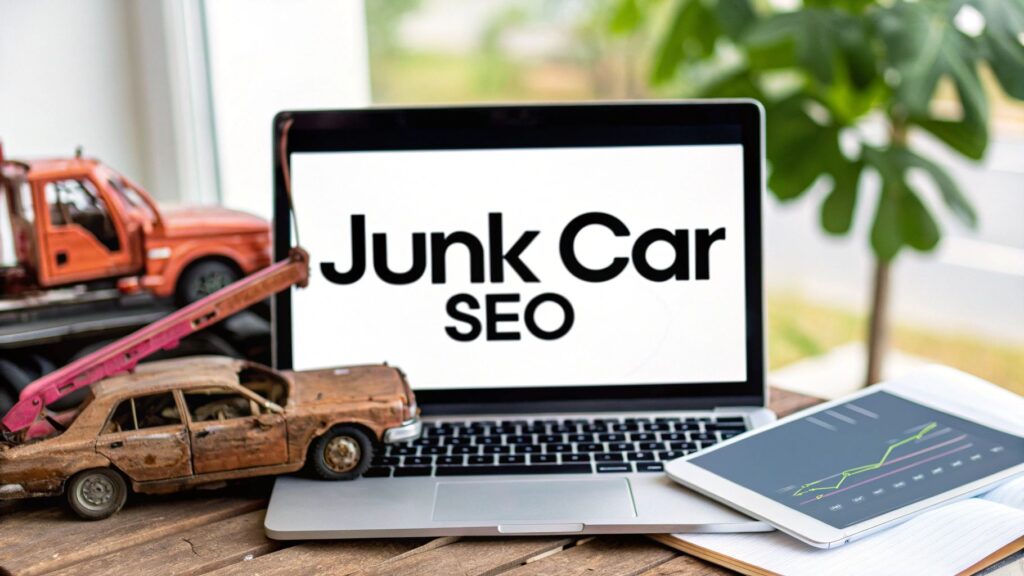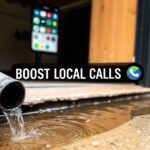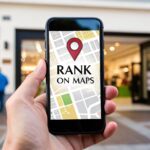You can be the best mechanic in town, but if local drivers can't find you online, it doesn't matter. Car repair SEO is how you make sure your shop appears when someone searches for help. It’s how you turn a "check engine light" panic into a new appointment.
In Short: SEO for auto repair shops connects you with local customers at the exact moment they need a mechanic.
Why Your Shop Needs More Than Just Good Service
Relying on word-of-mouth is the slow lane for business growth. While great service keeps customers coming back, SEO is what gets them in your door in the first place.
When a car breaks down, people grab their smartphones. If your shop isn’t on the first page of Google for "brake repair near me," you're invisible. This isn’t about being a tech expert; it's about being where your customers are searching.
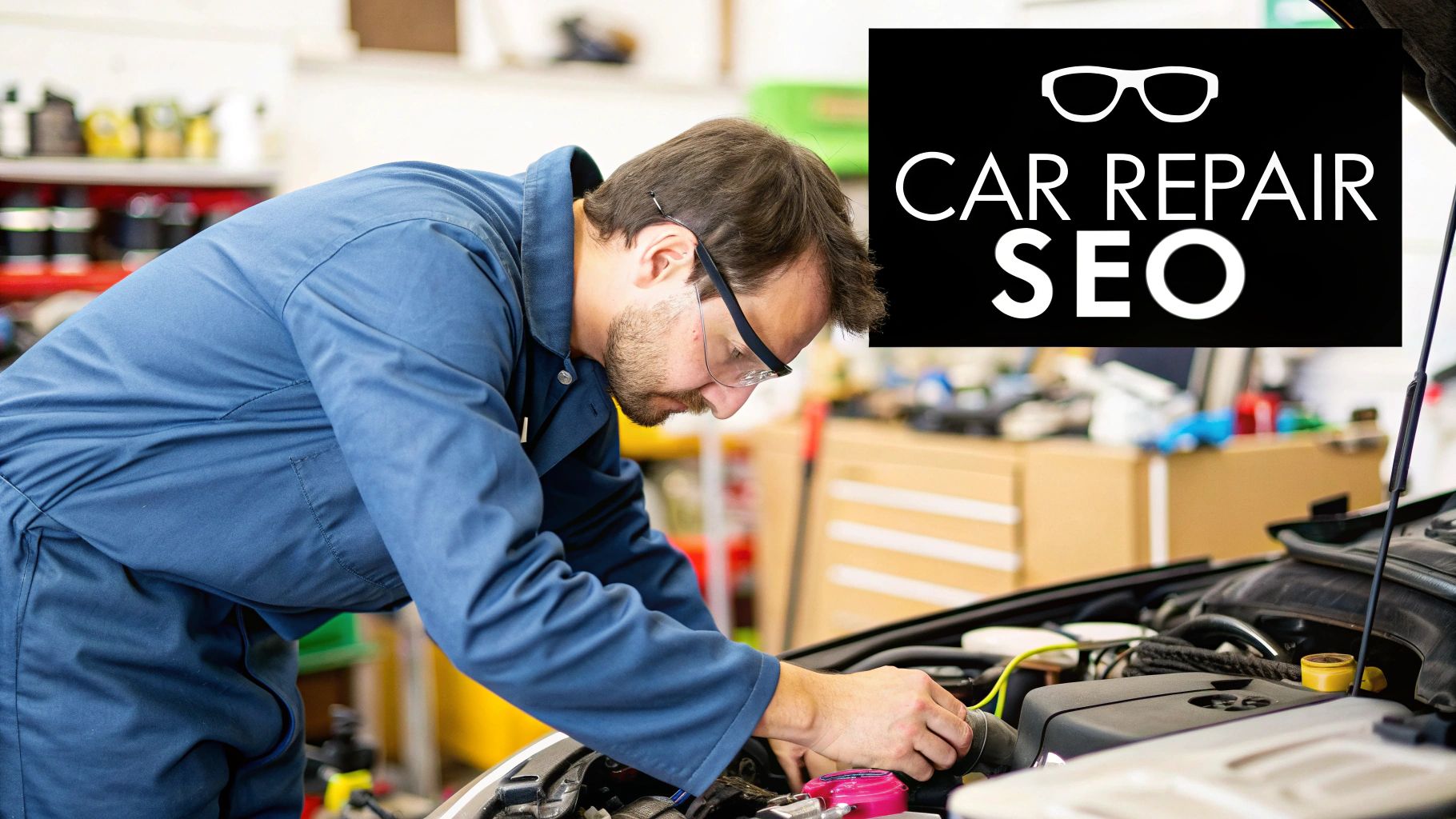
Building Trust Before the First Call
The auto repair industry has a trust problem. A huge 78% of drivers are skeptical of mechanics, and only 17% feel they're charged fairly. A solid online presence, built with smart car repair SEO, helps fight that skepticism.
A professional website and a well-managed Google Business Profile act as your digital handshake. They showcase your skills, feature real customer reviews, and clearly explain what you do. This transparency builds instant confidence. For more details, check out these marketing insights for auto repair shops.
So, What's the Real Point of SEO for a Car Repair Shop?
The goal is simple: connect your shop with local drivers the second they need you. When a car makes a strange noise, the owner’s first move is to search for answers online. Good SEO ensures your shop is the answer.
Here’s the breakdown:
- Boost Local Visibility: SEO puts you at the top of local search results.
- Get Qualified Leads: People searching for "alternator replacement" are ready to buy.
- Book More Appointments: More visibility means more clicks, more calls, and more cars in your bays.
SEO isn't just a marketing cost. It's a key part of running a modern auto repair business that keeps your schedule full and your shop growing.
Winning the Local Search Game
To get more cars in your bays, you must show up in local search results. For any shop doing car repair SEO, this starts with your Google Business Profile (GBP).
Think of your GBP as the digital front door to your shop. It's often the first thing people see when they search for "mechanic near me." To convince Google you're the best local option, you must fill out every single field.
Your Google Business Profile Is Your Best Friend
Your GBP is a powerful tool for attracting new customers. A complete profile gives Google all the information it needs to recommend your shop with confidence.
A fully optimized profile must include:
- Your Exact Business Name: Match it to what’s on your physical sign. Don't add extra keywords.
- The Right Address & Service Area: Pin your location correctly and outline the neighborhoods you serve.
- A Working Phone Number: Use a direct line where customers can book appointments.
- Up-to-Date Business Hours: Keep these current, especially for holidays.
- A Detailed Services List: Be specific. List everything from "oil change" to "transmission diagnostics." This helps you appear in specific service-related searches.
How Do I Optimize My Google My Business for Auto Repair?
Getting the basics right is just the start. To really stand out, you need to manage your profile actively.
First, upload high-quality photos of your shop, your team, and finished repair jobs. Regularly use the "Posts" feature to share updates about special offers or maintenance tips. Most importantly, ask for and respond to every single customer review.
What Is a Good SEO Strategy for an Auto Repair Shop?
A solid strategy is built on relevance and trust. It starts with a perfect GBP and ensures your business information is identical everywhere online. Consistency is key.
This leads to NAP (Name, Address, Phone number). Google cross-references your NAP info across online directories like Yelp and the Better Business Bureau (BBB). When your information is consistent, it builds Google's confidence in your business. Inconsistent details can hurt your rankings.
Hyper-local SEO is crucial. People search for things like “24-hour alternator repair near the old courthouse.” Keeping your NAP citations consistent boosts your authority and local relevance, which helps you rank higher in the Google Map Pack. These insights into auto repair marketing trends show how this can impact your traffic.
Your Essential Local SEO Checklist
This simple table helps ensure you've covered the basics for your shop's local SEO.
| Task | Why It Matters | Quick Tip |
|---|---|---|
| Claim & Verify GBP | This is your digital storefront. Without it, you're invisible on Google Maps. | Go to google.com/business and follow the verification steps, usually by postcard. |
| Complete Every GBP Section | A 100% complete profile gives Google more confidence to rank you higher. | Don't skip the "Services" or "Q&A" sections. They are keyword goldmines. |
| Consistent NAP | Inconsistent info across directories confuses Google and hurts your credibility. | Use a tool like Moz Local to audit your listings and find inconsistencies quickly. |
| Add High-Quality Photos | Pictures build trust and show customers what to expect. | Upload weekly photos of your team, your shop, and 'before and after' repairs. |
| Get & Respond to Reviews | Reviews are a huge local ranking factor. Google loves seeing fresh feedback. | Send a follow-up text or email with a direct link to leave a review. |
Nailing these basics puts you miles ahead of competitors.
Finding the Keywords Your Customers Actually Use
Great car repair SEO means thinking like your customer. "Mechanic near me" is popular, but when someone has a real problem, they get more specific. Your job is to answer those urgent searches.
This infographic breaks down a simple process for finding keywords that drive business.
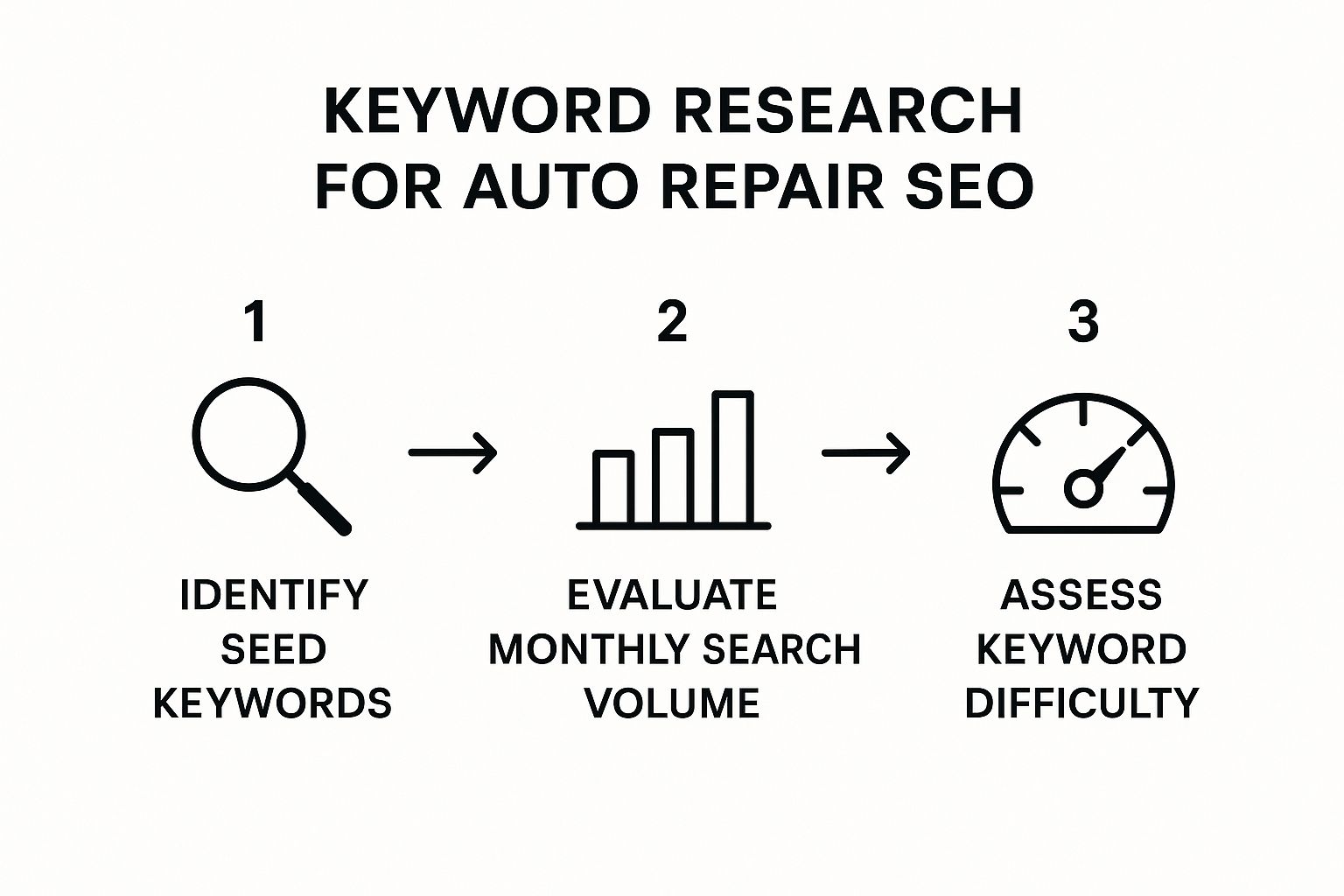
The secret is balance. Target high-volume terms, but also go for specific, lower-difficulty keywords for quick wins.
Think about how people search when their car breaks down:
- Not just "brake repair," but "squeaky brake diagnostic in downtown."
- Not "car AC service," but "car ac not blowing cold air fix [Your Neighborhood]."
- They look for answers to problems like "check engine light diagnostic near Main Street."
Using these long-tail, location-based keywords on your website and GBP helps you connect with customers ready to buy. To learn more, check out this guide on how to crush your local Maps SEO performance.
Building a Website That Actually Books Appointments
Your website is your shop's digital front counter. It's the first impression many people will have. It needs to be helpful, trustworthy, and easy to use. This is where on-page SEO turns your site into a tool that books jobs.
Your website is your hardest-working employee. It works 24/7, guiding customers and Google to the right information and making it easy to book a service.
Why Mobile-First Design Is Everything
Imagine someone stranded on the side of the road. They pull out their phone to search for help. This happens daily, which is why a mobile-first website is a must-have. Google primarily uses the mobile version of your site for ranking.
By 2025, over 96% of consumers will use smartphones to look up automotive services. If your site is slow or hard to use on a small screen, you're losing business. If a driver can't find your phone number immediately, they'll go to the next shop on the list.
🔑 In Short: Your website's performance on a smartphone is more important than how it looks on a desktop. Test it on your own phone.
Our guide has great examples of mobile landing pages that show how to turn visitors into customers.
How Do I Make My Auto Repair Website SEO-Friendly?
Making your site "SEO-friendly" means organizing it so both Google and customers understand what you do. The biggest mistake is putting everything on one generic "Services" page.
Instead, build a dedicated page for each main service. Customers don't search for "car services"; they search for "brake repair near me."
Create separate pages for:
- Brake Repair & Replacement: Cover everything from squeaking noises to the types of pads you use.
- Engine Diagnostics: Explain how you handle the check engine light and the tools you use.
- AC Recharge & Repair: Target people with broken AC, especially in the summer.
- Oil Change Services: Help you show up for searches like "synthetic oil change in [Your Town]."
- Timing Belt Replacement: A detailed page for big jobs builds trust and shows expertise.
On each page, include the service name, your city, and answers to common questions about that repair.
Crafting Service Pages That Rank and Convert
Your service pages are where you convince a visitor to choose your shop.
Here’s a simple formula for a great service page:
- A Clear, Keyword-Focused Title: Your H1 tag should be direct, like "Expert Brake Repair in Springfield."
- Lead with Their Problem: Start by addressing their issue. "Hearing a squeaking or grinding noise when you brake?"
- Present Your Solution: Explain your process and the parts you use. Transparency builds confidence.
- Add a Strong Call-to-Action (CTA): Use prominent buttons like "Request a Quote" or "Book an Appointment Now" throughout the page.
Following CMS best practices for SEO ensures your site's technical foundation is solid, helping your content get seen.
Creating Content Your Customers Will Actually Read
Good content does more than just fill space. It proves you know what you're talking about and answers the questions your potential customers are asking Google.
Forget generic blog posts. Create helpful, practical information that establishes your shop as the local expert. This is a key part of car repair SEO.
The goal is to create content that matches what people search for when their car has a problem. When you provide the answer, you build instant trust. You become a helpful guide, not just another shop.
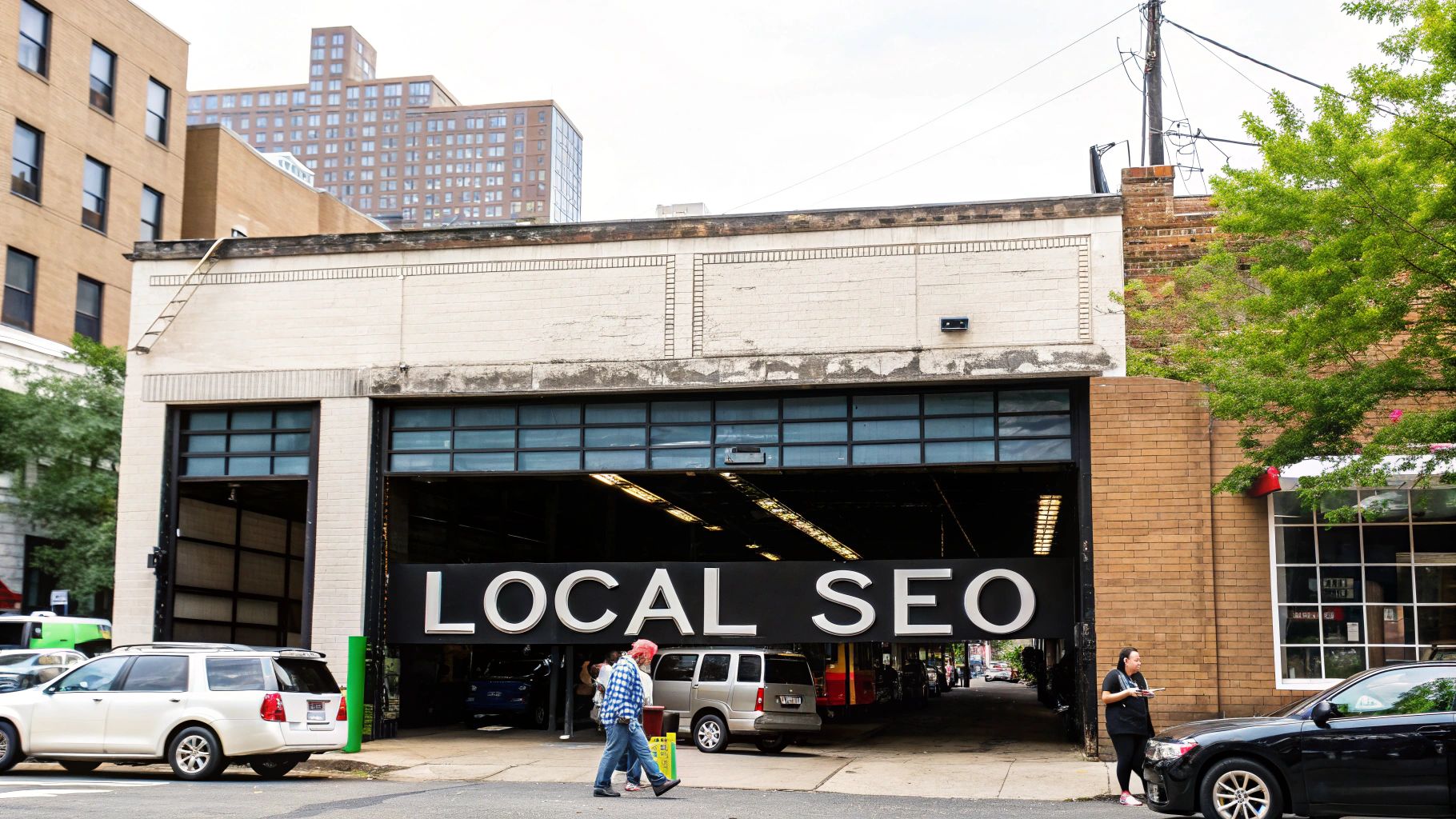
What Kind of Content Should an Auto Repair Shop Create?
The best content ideas come from questions you hear from customers every day. Turn these real-world problems into helpful articles, guides, and videos.
Here are a few ideas that work:
- Problem-Focused Articles: Get specific. "3 Signs Your Car Battery is About to Die" will perform better than a general page on electrical services.
- "How-To" Guides: An article like "How to Know if Your Brakes Are Failing" directly targets a panicked search query.
- Seasonal Maintenance Checklists: Offer timely advice like "Your Essential Winter Car Care Checklist."
This type of content signals to Google that you're an authority, helping you rank for the exact phrases people use when they need a mechanic. This guide on using Google's Keyword Planner can help you find these valuable phrases.
Answering the Questions People Actually Ask
To create content that connects, you need to think like your customers. Google’s "People Also Ask" feature is a great source for this.
Here are real questions you can turn into content:
- What are the signs of a bad transmission? This is perfect for a blog post with a bulleted list of symptoms like slipping gears or strange noises.
- How do I know if I need new tires? Create a short video showing the "penny test" or write an article explaining how to read tread wear indicators.
- What does it mean when my check engine light is flashing? A Q&A article could explain the difference between a steady and a flashing light.
Pro Tip: Give each question its own piece of content. A dedicated post on transmission problems is much more powerful for SEO than a single paragraph on a general service page.
Easy Formats That Get Results
You don't need a film crew to create great content. The simplest formats are often the most effective.
Consider these approachable content types:
- Q&A Articles: Take a common customer question and write a clear answer. It’s direct, simple, and matches search queries perfectly.
- Quick Diagnostic Videos: Use your smartphone to shoot a short video showing a worn-out part next to a new one. It feels authentic and builds trust.
- Checklists: People love scannable checklists. A "Pre-Road Trip Vehicle Check" is useful and easy to share.
Share your content on Facebook and your Google Business Profile to build a loyal local following.
Building Trust with Reviews and Local Links
In the auto repair business, reputation is everything. It turns a one-time fix into a lifelong customer. This trust translates directly into two powerful signals for Google: customer reviews and local backlinks.
Reviews are today’s word-of-mouth. Local links are like a digital handshake from other respected local businesses. When you get both right, you build a solid reputation that brings in customers.
How Do I Get More Reviews for My Auto Repair Shop?
A steady flow of great reviews is a huge win for local SEO. A strong profile on Google or Yelp builds instant credibility. In fact, 93% of consumers say online reviews influence their purchasing decisions.
The secret is making it easy for happy customers to share their experience.
- Ask at the Perfect Moment: The best time to ask is right after you've solved their problem. A simple, "Glad we could help! We'd appreciate it if you shared your experience on Google to help others find us."
- Make It Effortless: Send a follow-up text or email with a direct link to your Google Business Profile review page.
- Use a Simple QR Code: Put a sign with a QR code on your front desk. While a customer is paying, you can point to it and suggest they leave a quick review.
🔑 In Short: Don't be pushy. Most happy customers will leave a review if you make it easy and ask at the right time.
How Do You Handle a Negative Review for an Auto Repair Shop?
Negative reviews happen. How you respond defines your business. A bad review is a public opportunity to show you're committed to great service.
Follow this plan:
- Respond Quickly and Professionally: Acknowledge their comment publicly within 24 hours. Start with, "Thank you for the feedback. I'm sorry your experience didn't meet your expectations."
- Take It Offline: Don't argue online. Offer a path to a solution: "We want to make this right. Could you please call [Manager's Name] directly at [Phone Number]?"
- Learn From It: Use the criticism to find weak spots in your process.
This approach shows potential customers that you take responsibility and care, which can build more trust than a page of perfect reviews.
What Are Local Backlinks and Why Do They Matter?
A backlink is a link from another website to yours. When a local business links to your site, they're vouching for you. Google sees this as a vote of confidence that you're a trusted part of the local community.
This is about building real relationships in your area.
Here are a few ways to earn local links:
- Sponsor a Local Team: Sponsoring a Little League team or charity 5K often gets you a link on their website.
- Partner with Nearby Businesses: Team up with a non-competing business, like a local car wash, for a joint promotion.
- Join the Chamber of Commerce: Most local chambers have an online directory that links to their members.
- Host a Community Event: A free "Basic Car Maintenance 101" workshop can get you links from local blogs and news outlets.
These local connections are SEO gold. They tell search engines your shop is a key part of the neighborhood, which is a massive signal for local search rankings.
How to Know If Your SEO Is Actually Working
So you've put in the work. How do you know if it's paying off? The goal is to check a few key numbers that tell you if you're getting more calls and booking more jobs.
Tracking your progress is the only way to know what's working. The tools you need are free; you just have to know what to look for.

Key Metrics That Actually Matter
Let's cut through the noise. Focus on numbers that connect your online presence to your bottom line. Your two best tools are Google Search Console and your Google Business Profile insights.
Here’s what to watch:
- Phone Calls from Your GBP: Your GBP shows how many people clicked the "call" button from your listing. This is a direct sign that your local SEO is working.
- Website Clicks from GBP: This shows how many people found your profile and wanted to learn more.
- Appointment Form Submissions: Tracking submissions on your website is a direct measure of new business.
- Keyword Rankings for Your City: Use Google Search Console to see which search terms are sending people your way. Are you showing up for "brake repair in [Your City]"?
Pro Tip: Check these numbers monthly. A simple check-in is enough to spot trends and see if you're heading in the right direction.
How Can I Check My SEO Ranking?
This is easier than you think. You don't need expensive software.
Open an "incognito" or "private" window in your browser. This prevents your personal search history from affecting the results.
Now, search for your main keywords like "mechanic near me" or "oil change in [Your Town]." See where your shop appears. Are you in the Google Map Pack? Are you on the first page? Checking this monthly shows your progress.
What Is a Good KPI for SEO?
For a local auto shop, a good Key Performance Indicator (KPI) measures customer action.
The single best KPI is an increase in qualified leads. Calculate this by adding up the phone calls from your GBP and the appointment forms submitted through your website. That number tells you if your SEO is making the phone ring and keeping your bays full.
Common Questions We Hear About Car Repair SEO
Let's tackle some of the most common questions from shop owners.
How long does SEO take to work for a car repair shop?
You may see small signs quickly, like a few more calls from your Google Business Profile in a few weeks. But for real momentum, give it 3-6 months. SEO is a long-term strategy. Consistency is what leads to a steady flow of customers.
Can I do SEO for my auto repair shop myself?
Yes, you absolutely can. Much of local SEO—like updating your Google profile, asking for reviews, and writing about your services—is straightforward. This guide provides a roadmap. While hiring a pro can speed things up, you can make a big impact on your own.
What is more important for SEO: my website or Google My Business?
This is like asking if you need a wrench or a socket. You need both.
- Your Google Business Profile (GBP): This is your digital sign. It's the first thing people see in local searches and is designed to get you calls and directions, fast.
- Your Website: This is your virtual shop. It’s where you build trust, show your expertise, and convince customers to book a service.
A great GBP gets their attention, and a great website seals the deal. You need both working together.
Ready to stop spinning your wheels and start getting real, measurable results from your online marketing? The team at Clicks Geek lives and breathes SEO and ad strategies that keep service bays full. Learn more about our digital marketing solutions and see how we can help.
Is Your Business Ranking in Google Maps?
Turn Google Maps into a Lead Engine w/ Clicks Geek’s AI-powered local SEO. 3,000+ clients served. Our proprietary, fully done-for-you Maps SEO system handles everything—keyword targeting, local optimization, content, reviews, and ranking strategy—automatically.


